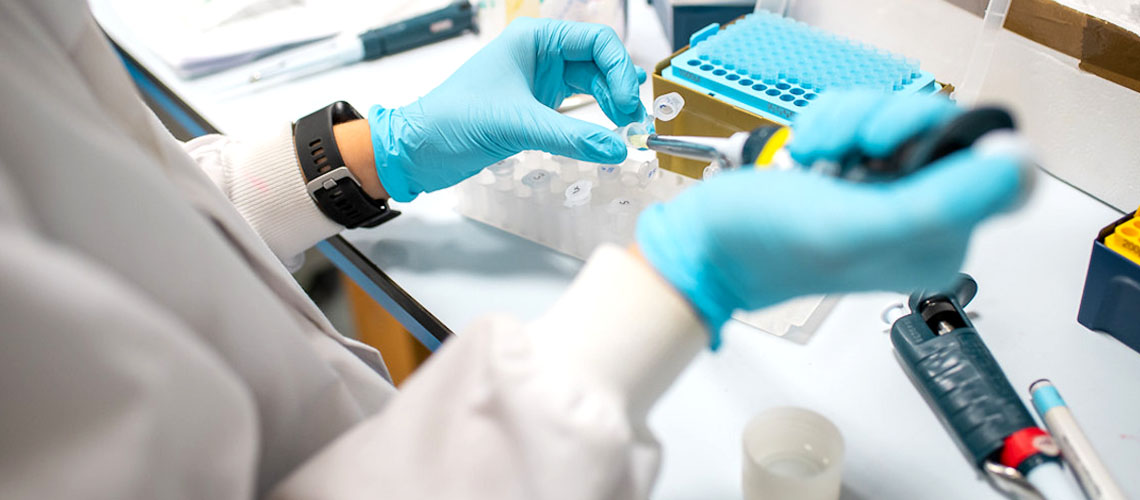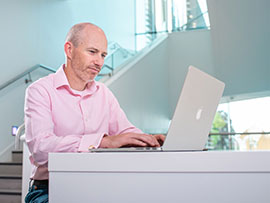Taking discovery research up a gear
The University of Manchester is pioneering new discoveries that could lead to new strategies to treat ovarian cancer. Professor Stephen Taylor, Head of the Division of Cancer Sciences, explains how a combination of high-quality basic research, translational science, drug discovery and the 'Manchester way' of doing things are yielding results.

For me, the key to any discovery is high-quality science; good processes, experimentation and interpreting the results with rigour are essential. For any research to translate effectively into clinical practice and patient care, it must be underpinned by high-quality science – and that's happening here.
An example of a University-led project that has high-quality science at its core is a collaboration between my lab, the Drug Discovery Unit at the Cancer Research UK Manchester Institute, and colleagues at The Christie NHS Foundation Trust.
This exciting venture involves researchers coming together to investigate the poly (ADP-ribose) glycohydrolase (PARG) enzyme and how it might be used to treat ovarian cancer.
Firstly, researchers at the Drug Discovery Unit developed a new drug to target the PARG enzyme. Then they reached out to us [at the Division of Cancer Sciences] to help them explore the effect of this new drug on ovarian cancer.
We discovered quite quickly that while some ovarian cancer cells were resistant, others were highly sensitive. This differential sensitivity was an exciting observation because it meant that there may be a subset of ovarian cancers with an underlying vulnerability that would make them sensitive to this new class of inhibitor.
We then explored the underlying mechanisms responsible for drug sensitivity and discovered that some ovarian cancer cells do indeed have an underlying vulnerability, in particular a DNA replication defect that makes them sensitive to this PARG inhibitor.
We validated this theory by testing the drug not only on additional cell lines, but also on fresh biopsies isolated from patients being treated at The Christie.
When we started this project, we were not experts in PARG or ovarian cancer. But by designing careful, high-quality experiments and following a philosophy of 'first principles', where you have to prove in principle that something works, we made a number of exciting discoveries that we hope to eventually translate into a clinical setting.

Professor Stephen Taylor
Stephen Taylor is Head of the Division of Cancer Sciences and Leech Professor of Pharmacology at The University of Manchester.
Doing things differently
We conduct translational science slightly differently at Manchester and work on different model systems. In my laboratory we have traditionally worked on established cell lines grown in culture, but more recently we have started working on viable cell cultures generated from patient biopsies. That's a relatively unique angle – we have set up a biopsy pipeline that delivers patient biopsies from The Christie right into our building.
Once in the lab, we isolate the tumour cells from patient biopsies, grow them and conduct high-resolution cell biology and drug sensitivity profiling. At Manchester, we carry out chemotherapy experiments in the lab rather than in the clinic.
This contrasts with more traditional cancer pathology methods, which use cells that have been fixed. These aren't 'living' cells – you can look at them, but you can't test drugs on them.
By contrast, our approach allows us to observe living tumour cells – we can watch them divide and proliferate.
We can also watch to see if they die when we add chemotherapy drugs, either ones that are already in use in the clinic or new ones that are being developed, like the PARG inhibitors. We can analyse the cultures over a number of days and weeks, and actually start to measure chemotherapy responses in the lab.
“Our approach allows us to observe living tumour cells – we can watch them divide and proliferate.”
The road to translation
After almost 15 years working on discovery science, my team and I wanted new challenges, and to explore new avenues. This led us to focus more on translational research.
I was interested in applying our experience and high-quality, rigorous, discovery-science approaches to an area which, at the time, was not getting a lot of interest: the biology of chromosome instability in the context of ovarian cancer.
A lot of the existing cancer genomics approaches were based on the analysis of dead cells, whereas I wanted to apply our mitosis expertise to high-resolution cell biology analysis on living cells isolated from patient-derived material.
Some people would describe this as reverse translational science, as opposed to traditional translational science, where you hope that experiments conducted in a lab will move into a clinical setting.
Instead, what we're doing is taking the patient material from the clinic and bringing it into the lab to learn more about the biological processes driving the disease.
This kind of approach has traditionally been done with established cell lines, but they often aren't representative of the specific disease you are researching. By contrast, establishing ex-vivo cultures from patient biopsies has several advantages. First and foremost, because we work very closely with The Christie, we have access to the full clinical histories of the patients. We know exactly what kind of disease they've got, what chemotherapy is being used and whether or not they respond to the treatments. You have none of that when you use established cell lines.
Also, as we build our living biobank, we are collecting more and more samples, including biopsies from the same patient before, during and after their treatment. We would also like to be able to examine tumours collected post-mortem to help us understand the biology of the tumours that have caused the death of the patient.
“I can see how Manchester is really going to take off and become one of the best places in the world to do cancer research.”
Making the dream a reality at Manchester
Returning to our collaboration with the PARG inhibitor, we tested it on some of the samples from our living biobank and discovered that while some were sensitive, others were resistant. Moreover, we could show that resistant samples could be made sensitive by treating them with this new drug in combination with another drug that is in development.
This is very exciting as it encourages the development of ideas and hypotheses about new drugs, new drug combinations and the biomarkers you'll need to set up clinical trials.
Ultimately, what I want to build is a living biobank of viable cultures that have been generated from a range of biopsies – isolated at presentation, at the time of surgery, during chemotherapy, at relapse and at death – so that we can see how mitosis and chromosome instability in ovarian cancer cells evolve and change over time and in response to treatment. Also, a biobank of well-characterised samples would provide an amazing test bed for new therapeutic drugs.
To have a biobank of 100-plus highly characterised, well-understood samples that we can routinely screen against libraries of drugs – for example, all those already FDA-approved – to identify novel drug combinations on a patient-by-patient basis that you wouldn't have explored otherwise, would be incredible. It would be the dream.
There are challenges around realising this: high-quality science requires high-quality investment, but I have a great team in a fantastic environment, and so I am confident we will succeed. Indeed, I can see how Manchester is really going to take off and become one of the best places in the world to do cancer research. It's incredibly exciting to be part of something that's on the way up, as opposed to something which is just maintaining status quo, and Manchester isn't standing still.
Learn more about cancer research at Manchester.
